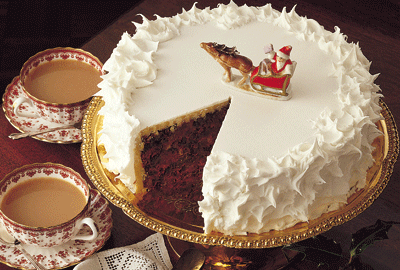
4 Very British Christmas Desserts - Christmas Cake, Christmas Pudding, Mince Pies, Sherry Trifle.
Christmas Cake is an English tradition that began as ‘plum’ porridge. (Plum is the old English word for dried fruit). People ate the porridge on Christmas Eve, using it to line their stomachs after a day of fasting. Soon dried fruit, spices and honey were added to the porridge mixture, and eventually it turned into Christmas pudding.
*You can now find mini Christmas Pudding with hot whisky marmalade on our Festive High Tea*
In the 16th century, oatmeal was removed from the original recipe, and butter, wheat flour and eggs were added. These ingredients helped hold the mixture together, resulting in a boiled plum pudding. Served with hot brandy sauce or rum butter.
Richer families with ovens began making fruit cakes with marzipan, an almond sugar paste, for Easter. For Christmas, they made a similar cake using seasonal dried fruit and spices. The spices represented the exotic eastern spices brought by the Wise Men. This cake became known as ‘Christmas cake’. Today a traditional English Christmas Cake is covered in marzipan and Royal icing, a recipe from the Victorian era when Queen Victoria was married to Prince Albert of Germany. Marzipan is a German creation and the Royal Icing represented the Crown.
The traditional Scottish Christmas cake, is known as a

Dundee Cake and has no marzipan or royal icing but instead is decorated with whole almonds and candied cherries on the top. It is a lighter crumbly cake with currants, raisins, cherries and of cause a good helping of Scotch whisky.
The trick with a great Christmas cake is in the timing. All Christmas cakes are made in advance. Many make them in November, keeping the cake upside down in an airtight container. A small amount of brandy, sherry or whisky is poured into holes in the cake every week until Christmas. This process is called ‘feeding’ the cake.
Mince Pies

are a fruit-based sweet pie of British origin that is traditionally served during the Christmas season in the English-speaking world. Its ingredients are traceable to the 13th century, when returning European crusaders brought with them Middle Eastern recipes containing meats, fruits and spices. Mincemeat developed as a way of preserving meat without salting or smoking some 500 years ago in England, where mince pies are still considered an essential accompaniment to holiday dinners just like the traditional plum pudding. This pie is a remnant of a medieval tradition of spiced meat dishes, usually minced mutton, that have survived because of its association with Christmas. We are accustomed to eating mince pie as a dessert, but actually “minced” pie and its follow-up “mincemeat pie” began as a main course dish with more meat than fruit (a mixture of meat, dried fruits, and spices). As fruits and spices became more plentiful in the 17th century, the spiciness of the pies increased accordingly. Today in Britain, beef suet is used in mincemeat. Meat is no longer used.
Tina's version using Tina's 20 year old recipe to create a vegetarian option with grated apple as a replacement.
*You can order Tina's mince pies from Market Wagon for local delivery or pick up in store*
Trifle (TRI-fuhl) The word “trifle” comes from the old French term “trufle,” and literally means something whimsical or of little consequence. In English cuisine trifle is a dessert made with a thin layer of sponge fingers or sponge cake soaked in sherry or another fortified wine a layer of fruit jelly (jello) and fruit like strawberries and a layer of cold custard, topped with whipped cream and hundreds and thousands (sprinkles).
Tina's Traditional Old English Kitchen will have mince pies on the Holiday High Tea throughout December and you can even take a pack home with you.
You can order these items from our buffet to go menu in time for the holidays by calling 317 565 9716 before December 18th for collection on or before Christmas Eve.
Happy Holidays!
Tina
